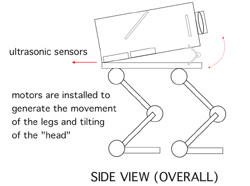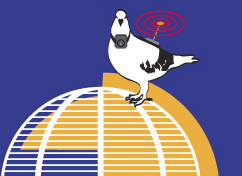Annie On Ni Wan Hong Kong Container “The phenakistoscope (also spelled phenakistiscope) was an early animation device, the predecessor to the zoetrope. . . . The word "phenakistoscope" comes from Greek roots meaning "deceiving viewer"."
Wikipedia Phenakistoscape is a kinetic interface through, which is an experiment in the metaphysics of moving image projection and an exploration of the language of mobile projection, with particular emphasis upon on its distinctive temporal and spatial modalities.  Phenakistoscape uses a custom-made biped robotic video projector. The camera movements of the moving images take control of the movement of the robotic projector, which pans to left when there is a pan to right shot in the video and tilts up when there is a tilt down shot. The robotic video projector walks randomly with slow speed inside the container space as well. Phenakistoscape uses a custom-made biped robotic video projector. The camera movements of the moving images take control of the movement of the robotic projector, which pans to left when there is a pan to right shot in the video and tilts up when there is a tilt down shot. The robotic video projector walks randomly with slow speed inside the container space as well. With Phenakistoscape, a mechanical algorithmic approach to video projection is introduced as a language of mobile video projection. New methods for extending the practice of moving image space within physical space are presented as a dynamic and unexpected labyrinth that reconstructs the architecture of time and space. Phenakistoscape presents an entirely distinct scheme for unfolding the profound poetry encoded in cinematic space, and hence it effects the creation of an exceptional perception of moving images.
Substantial theories from visual science explain how we see and how our visual perceptual mechanism works. According to established visual science and visual psychology, the orthodox view of how we perceive images states that our sight is solely detection/ recollection of light and patterns. We have no direct contact to the object we are seeing. Perception is a simple process of neurons' reception. What falls on the retina is the reciprocal of the object image. There is a lot of evidences to prove the incompleteness of this idea. For example, how can we tell how close an object is if we just see one single object. Some other principles may explain what is lacking from this orthodox view. One of the most significant "other principles," which focuses mainly on the way we perceive vision in relation to our environment and contact with physical space, is the ecological approach by the perceptual psychologist J.J. Gibson. Gibsonian theory is being adopted as the basis for Phenakistoscape. It is an approach that brings up the problem of both our visual and motion perception in relation to video projection. Gibson states that our visual perception is not a construction of inner experience but it is part of the process, which drives us to prolong our actions. The starting point of visual perception is not in the retina, it is in ambient light rays. Visual perception is active and it is an association of our motion/ action, as compared to the orthodox view of how an image “falls” onto our retina, which is a passive action. Visual perception is a collection of ambient light rays, which also requires motion. For example, we move our head and body when we are looking for something. In Gibson's theory, visual perception is part of how we perceive the environment and how we perceive ourselves. The process is complimentary and relational. |
